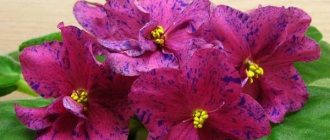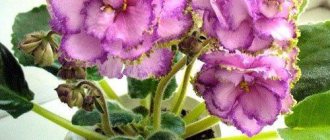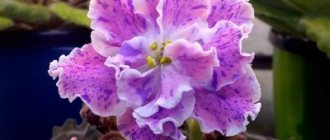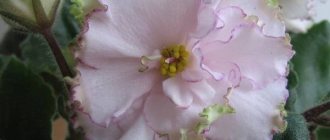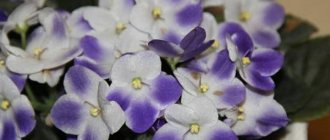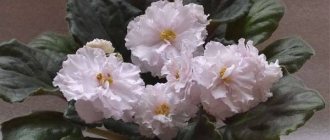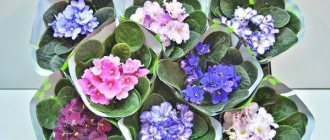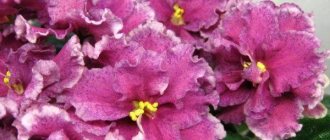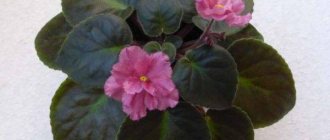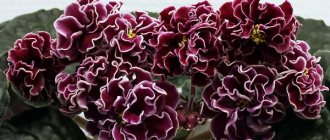The flower, very reminiscent of the violet common to European deciduous forests, is mentioned by the German Baron Saint-Paul in a letter to his father, the president of the German Dendrological Society.
Baron Saint-Paul of the East African region in those years
The governor attached the seeds of the plant to his message . More than two hundred years have passed since then, and a native of the Uzambara Mountains, named after the discoverer Saintpaulia, decorates many houses and greenhouses.
Violet Summer Night (K. Morev)
The author of the delicate, airy Saintpaulia is Konstantin Morev, a breeder from Moscow. The name of the variety, produced in 2007, was inspired by the light purple color of the buds, reminiscent of a warm summer night.
Let's take a closer look at the violet:
- Summer night - Uzambara violet of the Gesneriev family ;
- genus – Saintpaulia hybrid ;
- flowers - light, voluminous double and semi-double stars 5-6 cm in size, color - soft purple, white in the center. The petals are framed with a white border. Blooms profusely;
- leaves are bright, rich green, slightly wavy. The rosette is neat, large, slightly loose. It harmoniously combines with strong peduncles and voluminous, light flowers. The root system is well developed.
violet Summer night.
Light blue prints appear if the room was cool when the buds were planted. The flowers themselves will be lighter, in some cases almost white.
Important! In rare cases, the Summer Night violet forms sports.
Violet PT-Kuryanochka (T. Pugacheva)
Fantastic violet PT-Kuryanochka.
The variety PT-Kuryanochka belongs to the botanical species Uzambara violet.
Systematic position of the species :
- Family Gesneriaceae – Gesneriaceae;
- Genus Saintpaulia hybrid – Hybrid Saintpaulia;
- Species African violet saintpaulia hybrid.
History of the variety
Breeding of Saintpaulia began in the second half of the 19th century . In the USA to this day there is a strong school of breeders, setting the tone for the global community.
In the Soviet Union, new varieties of Uzambara violets began to be developed in the mid-20th century . The achievements of some domestic breeders are recognized abroad.
The author of the PT-Kuryanochka variety is a breeder from the city of Kursk , Tatyana Pugacheva. The varieties authored by Tatyana are characterized by:
- Long cap flowering;
- Large corollas;
- Dense, stable peduncles and petioles.
Photo and description of the variety
The PT-Kuryanochka variety blooms with very large simple, sometimes semi-double stars . The edge of the petal is wavy. The corollas are fuchsia-lilac in color, with a white[/anchor] eye, the edges of the petals are also white. Blooms profusely and for a long time.
The variety blooms well and abundantly.
The outlet is neat. Leaves :
- Medium green;
- The central vein is slightly lighter.
Saintpaulias are home plants that require careful care . There are few difficulties in agricultural technology, but there are some secrets and features.
Caring for a plant at home
Saintpaulias grow at home without problems if you provide them with the following favorable conditions and proper care.
Irrigation regime
Proper watering is very important for violets. The Summer Night variety does not tolerate overwatering . If there is excess moisture and it gets on the leaves (especially the center of the rosette), the plant may rot.
If the soil is dry, the leaves turn yellow, growth slows down, and the flowers become smaller . The need for watering is determined by the condition of the soil. It should dry about 1 cm.
The water is preliminarily settled for a day. During this time it warms up to room temperature. When watering with cold water, brown spots appear on the leaves.
Water with a watering can with a long spout so that a stream of water can hit the soil without touching the leaves.
You can feed the plant with moisture through a tray . In this case, make sure that the water in the pan does not stagnate and is always fresh.
Another method of watering is wick. The wick is made from cloth. It is inserted into the drainage holes of the pot, and the other end is lowered into a container of water. The pot is placed on the container so that it does not touch the liquid. The fabric wick absorbs water, moistens the soil and provides moisture to the plant.
During active growth, development and flowering, violets are fed. Use any compositions for flowering indoor plants that are sold in the store. To avoid oversaturation with drugs, they are diluted with water until the concentration is halved.
All fertilizers must be diluted more than what is written in the instructions.
Feeding is carried out no more than once every 10 days . To ensure that the leaves are not too large and compact, nitrogen fertilizers are limited .
Lighting
Saintpaulia Summer Night prefers diffused, natural light. Daylight hours should be 11-13 hours . Therefore, in winter, when there is not enough sunlight, fluorescent lamps are used.
During hot weather, cover the windows with film or paper, preventing direct sunlight from falling on the flowers. This will protect the leaves from getting burned. If the light is too bright, the petals fade to a warm lilac color.
Air temperature
The optimal temperature for good development of Saintpaulia is 20-24 ° C. In winter it can drop to 18 °C.
Attention! At lower temperatures there is more white color on the petals. In the heat, the plant slows down all life processes, as if it freezes. Ice bottles placed between flower pots will help you survive the heat.
Remember, violet is afraid of drafts.
Humidity
For good development of Saintpaulia, air humidity should be in the range of 50-55% :
- with high humidity, the plant may rot;
- if it is low, growth and development will slow down significantly.
It is possible to increase humidity by placing open containers of water. It is good to use humidifiers.
Priming
The soil for growing Saintpaulia at home is chosen to be light, breathable, with a sufficient amount of minerals (potassium, phosphorus), with a moderate amount of nitrogen, with a pH of 5.5-6.5. Forest soil with the addition of biohumus, peat and vermiculite is well suited.
Hygiene
To make the plant look more impressive and neat, hygiene is carried out regularly. It involves removing yellowed, wilted, lower leaves, dried flowers and peduncles. If the stem of the plant is too bare, then it is sprinkled with earth.
The leaves can be periodically washed to remove dust . The soil is covered with a film, the flower is tilted and the dirt is washed off with a shower. It should be remembered that after this procedure the violet must be dried thoroughly and only then placed on the windowsill. Spots may appear on wet leaves from the sun.
Reproduction
The Summer Night variety is easy to propagate. You can use leaf cuttings, stepsons, peduncles.
Summer Night is easy to propagate.
Transplantation and rejuvenation
Saintpaulias are replanted 1-2 times a year. The best time for this procedure is spring. It is necessary to completely change the soil only if the violet has not been replanted for 2 or more years:
- Before replanting the plant, moisten the soil to make it easier to remove it from the pot and not damage the roots;
- The pot is turned over and the violet is transferred to a new container on a layer of drainage and soil;
- Align the plant in the center, fill the voids with fresh soil.
Those Saintpaulias that have a long stem . It is cut off, leaving 1 cm along with 5-6 leaves. They put it in water, wait for the roots to appear, then transplant it into the ground. After 2-3 weeks the plant will take root completely. During the rooting period, it is covered with film.
An old violet with a long stem can be rejuvenated.
How to tame the PC-Golden Dragon
Last September I went to the violet exhibition for the first time - just to look. And here is the story about who I saw there. To maintain the intrigue, I first publish a photo of what the little dragon looked like on the day of purchase.
At home I read about the variety and was surprised that the leaves of my baby did not look like the varietal ones - straight instead of wavy, the shape was different, and they were also light. It turns out that this is a peculiarity of the variety - not only the juvenile leaves do not look like the variety, but also several subsequent pairs.
He moved with me along with the Izyums - in a plastic bucket, wrapped in a shirt. Upon arrival, it grew a little, so I transplanted it. Suddenly, the leaves at the growing point began to grow not in pairs, as before, but in triplets. You can clearly see it here:
The next batch of leaves again appeared in pairs, then again in threes - in general, they grow as they want. I soon noticed that this violet began to pull its leaves upward, although the other children had ordinary flat rosettes. Some leaves grew without any logic - for some reason they turned around their axis, for example. After the transplant, a spot appeared on the juvenile leaf right before our eyes (there was no draft). The newly formed stain can be seen in the second photo, on the leaf on top. The dragon grew somewhat lanky and unsightly, the leaves were smaller in the center, the petioles were thin, while the leaves themselves looked like oak (and they did not lose turgor even when underwatered). He constantly placed the leaves vertically, despite the fact that he stood in bright light and was illuminated by a lamp for a long time. The daylight hours eventually reached 15 hours, but this was not enough for the Dragon. If you turn down the lighting a little, that’s it, hands up. I lifted the leaves in just a few minutes, but then you couldn’t persuade them to lower them. It was wobbly in the pot, despite the fact that it had good roots and was normally covered - to the base of the petioles of the lower leaves. You take the pot and it falls on its side. For some time there was no lamp - ours broke, they couldn’t get a new one. The late winter southern sun alone did a good job of illuminating the Dragon, and he even built something more or less decent out of leaves and reminiscent of a rosette:
Yeah, I’ll give you a tolerant socket, right now. Cloudy days came, and the Dragon folded. I didn’t take pictures of this disgrace, although it wouldn’t hurt. But it didn't look very good, really. I would even think that I myself was crooked, but good rosettes of other varieties dissuaded me of this. And so on constantly, until a new lamp. The sun is peeking out - the sunny days are here to stay - the dragon is spreading its wings - don't you miss the rain there? Even a pattern has been established: if the PC-Golden Dragon looks like a violet, it means it will rain tomorrow. Months later it was still hanging out in the pot, even though it was growing and all. Then the leaves began to spin, become smaller and turn pale. The “old” ones were very dusty, the tassel was lost somewhere in the things - moving is such moving. I found another brush and cleaned one sheet, but the brush was not particularly effective. I decided to wash the Dragon, as advised in articles about washing violets. I rinsed the outer leaves under warm water, wiped and dried everything. I didn’t like the water, pale spots immediately appeared, and one leaf suddenly lost turgor. Suddenly - because it was the one that was being cleaned with a brush. I thought I had done something wrong, but I washed the leaves of some other varieties, and nothing happened to them. In the photo, the leaves turned out to be overexposed; they were still not so gray, but still faded and ugly:
It grew, staggered and stretched upward, young leaves stuck at one stage of growth. Several “old” ones fell off for no reason. They didn’t rot, they just took it and died. That's how he wanted it. One day he got me. She came home from school hungry and angry, took a pot with a diameter of 11 cm (the Dragon grew in the nine) and moved her monster. He still pulled his paws, staggered and looked like a pale infirmity. One day he fell heavily on his side and did not want to correct himself, no matter how much I supported him and gave him some powder. She waved her hand and left. It grew. Starting to take steps. By the way, he released his first stepson soon after he just moved in with me, but the stepson turned out to be smart and committed suicide. Grown up. Began to resemble a violet:
Oh, that means he liked the big volume better. I watched further. And I understood why it was the Dragon. Gold - understandable. Dragon - probably because of the size of the flowers? Not a fact. Remember the Lernaean Hydra, from which if you cut off one head, three will appear? Also a dragon-like creature. So, the stepsons of the Golden Dragon are the heads of the hydra. I delete one - several others appear, and even from that same bosom a new one creeps out. I removed about eight of them, if not more, and there were still a couple left, because you can’t pick them out. The leaves are dense, grow close to each other, and I scratched some when I removed the stepsons. The leaves, however, didn't care. One stepchild formed right under the youngest leaf, near the growing point, and had to wait until another batch of new leaves grew. A whole month of stepsons. They are everywhere. And now here's what:
I forgive him everything. It is huge and yellow, and yellower in life. Now the flower is 7 cm. The buds are simply gigantic, stuffed and creamy. When the first flower stalk appeared among the army of stepchildren, it was a holiday. The camera refuses to capture the true color. When the flower bloomed, it was rather creamy; now it is white with bright lemon streaks on each petal, which are printed on the back side, as if the white petals were painted with a yellow highlighter. It no longer wobbles, and the turned-up mudflaps like leaves are its highlight. One peduncle, by the way, is also strange - it climbs out of one bosom and tends towards another. But this doesn't spoil anything:
Such varieties are needed in the collection. When some are flexible and ideal, it’s great, but it’s also boring. And the Golden Dragon not only requires care - it deserves it. Impressions about the variety itself: 1. It needs a lot of light, very, very, very much light. While Raisin is overexposed, the PC-Golden Dragon is underexposed. The leaves are rising in the center - definitely not enough light. 2. It's really yellow! And even the first time. And huge. 3. Young leaves that do not resemble the variety are the norm. 4. A beginner runs the risk of killing his nerves and self-esteem. In addition to the Golden Dragon, it is advisable to keep several docile varieties with an even rosette, such as Optimar or Summer Twilight. 5. He's not very fast. I bought a baby about 3-4 months old, the Dragon bloomed a little over 8 months after the purchase. 6. The leaves are powerful, it is difficult for them to lose turgor. 7. Prefers a large pot, at least for me. 8. Doesn’t require a lot of water, despite its large size. The result is a cool, beautiful variety with character that requires patience and taming. I'll see how it behaves further.
Features of flowering, growth and reproduction
Violet Summer Night develops well at home and can adapt to environmental conditions. You do not need to have specific growing knowledge. It is enough to know the following features of flowering, growth and reproduction of Saintpaulia:
- it reproduces well by leaves and produces many children. The main thing is to choose the right leaf for planting. It must be absolutely healthy, without spots, damage, brightly colored, and of correct shape. It is cut with a blade at an angle of 45°. Pour settled water into a disposable glass, dissolve an activated carbon tablet in it, and place the leaf handle in the liquid. Leave until roots about 1 cm long grow. Then they are transplanted into prepared soil, covered with film until completely rooted;
Leaf propagation.
- on average, after 5-6 weeks a baby is formed. After 6-8 months she turns into a strong starter. After 12 months it becomes an adult plant, ready for its first flowering;
- Summer Night conveys varietal characteristics well . Sometimes sports can form. They manifest themselves in changing shades of colors;
- peduncles are strong . Flowering of Saintpaulia Summer night is abundant and caplike. In one bouquet, buds can have different shades. Young ones are brighter in color. During the long flowering process, the color becomes lighter. Flowers last up to two months;
- blooms irregularly . Each bloom can appear in different shades of purple - from light to darker;
- in hot weather the petals become brighter, in cool weather they become lighter;
- At low temperatures, the flower stalks become longer.
Violet Svetlana: variety replanting
Violet Svetlana: photo of the variety
The soil should not be heavily saturated with fertilizers; you also need to monitor the nitrogen content in it, it should be small. If this is not observed, the plant will form with monochromatic green leaves.
It is important to add pine needles to the soil, as well as peat, and sand from the coast. You also need to add vermiculite, it helps the soil not become compacted.
You will need an average size container of fifty to sixty millimeters for babies, seventy to eighty millimeters for teenagers, and ninety to one hundred and twenty millimeters for mature plants. The first layer should be a drainage layer; it is laid in a layer of thirty to fifty millimeters.
Young plants need to be replanted with their earthen ball on the roots; they are placed in a large container and covered with soil on top. When transplanting, mature flowers are cleared of old soil. You can moisten the plant only a day after transplanting.
Reviews
Flower growers and connoisseurs of violets respect the Summer Night variety by Konstantin Morev, noting the plant’s unpretentiousness in care and the diversity in the shades of the petals.
Sergey. “The variety is gorgeous. The violet bloomed for the first time on the shelf. Therefore, the petals turned out to be very dark. This did not spoil the appearance; on the contrary, it added zest to it. It turned out to be an interesting option.”
Tatiana. “This is one of my favorite varieties for a long time and I think forever. Not greedy for flowers, bright, so different depending on temperature and lighting. It just warms the soul!”
Alice. “I love this violet! So neat, not capricious, blooming for a long time, sometimes bright, sometimes lighter. It pleases the eye with its rosette and lush bouquet. What else does an amateur gardener need to be happy!”
Diseases and pests
If you care for the Svetlana violet variety poorly, you can cause rotting on its stems, and then:
- Late blight is a fungus that moves from the ground to the plant due to a large amount of moisture. The leaves become covered with spots. Only Fitosporin solution will help in the fight. If the flower is already covered with a high degree of infection, then it cannot be cured. You can only tear off a healthy leaf and plant it using rooting.
- Fusarium is a fungus that can appear if you moisten it with cold water or overwater the soil. Symptom: leaves begin to fade.
- Powdery mildew - a white coating appears on the leaves. The disease occurs from the ground or from dirty water. This may be due to lighting, cold, stagnation in the soil, or a large amount of nitrogen in the diet. Fundazol or Topaz will help in the fight.
- Gray rot - the leaves begin to change color to red, first spots appear, then a gray coating begins to accumulate on them. You can only fight it if the disease is early, cutting off the diseased leaves, then you need to spray the plant with a solution of potassium permanganate.
- Vascular bacteriosis - this disease can occur in hot weather; metabolism in the plant is lost. The leaves or stems become transparent and eventually become soft. The rosette withers for about fourteen or twenty days. As soon as you notice symptoms, immediately adjust the air temperature in the room and disinfect the plant with trichodermine.
Harmful insects: aphids, thrips, scale insects and false scale insects, nematodes, mites, worms.
It is necessary to protect the Svetlana violet variety immediately; the plant that was attacked by the insect should be transplanted into another container, into new soil, cutting off all diseased shoots. Next, spray with disinfectant preparations, for example, Fitoverm, Aktara or Alarat.
Attention! If you see swelling on the roots, then the plant has been attacked by nematodes. In this case, treatment is useless, the flower is sick and will soon die. If you want to leave offspring, then cut off a healthy leaf and root it, but before doing this, disinfection with potassium permanganate is necessary.
